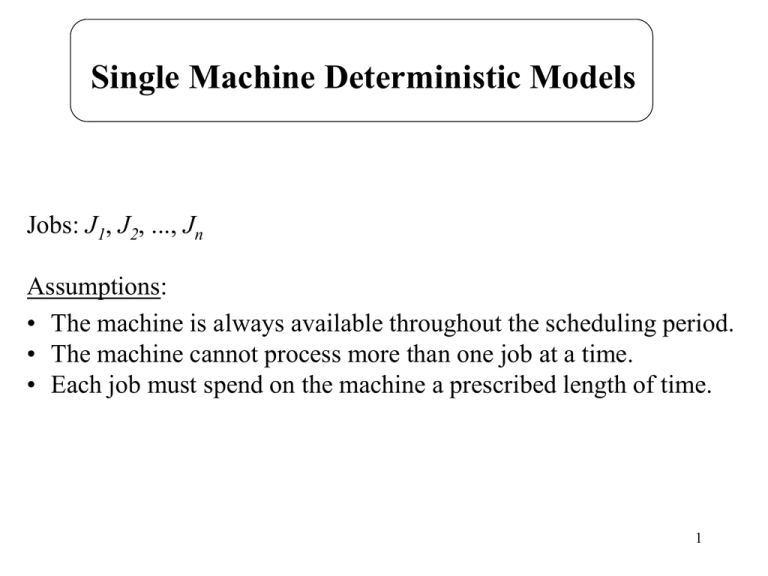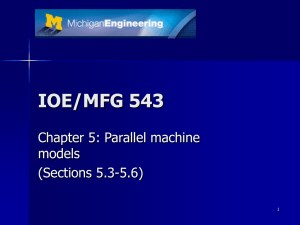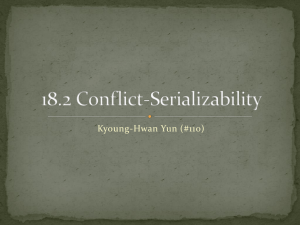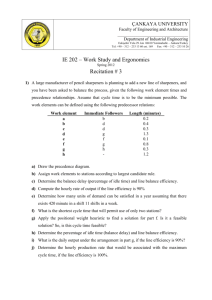12_singlewcompl.ppt
advertisement

Single Machine Deterministic Models Jobs: J1, J2, ..., Jn Assumptions: • The machine is always available throughout the scheduling period. • The machine cannot process more than one job at a time. • Each job must spend on the machine a prescribed length of time. 1 k S (t ) 0 if job J k is processed at time t if no job is processed at time t S(t) 3 2 1 t J2 J3 J1 ... 2 Requirements that may restrict the feasibility of schedules: • precedence constraints • no preemptions • release dates • deadlines Whether some feasible schedule exist? NP hard Objective function f is used to compare schedules. f(S) < f(S') whenever schedule S is considered to be better than S' problem of minimising f(S) over the set of feasible schedules. 3 1. Completion Time Models Due date related objectives: 2. Lateness Models 3. Tardiness Models 4. Sequence-Dependent Setup Problems 4 Completion Time Models Contents 1. An algorithm which gives an optimal schedule with the minimum total weighted completion time 1 || wjCj 2. An algorithm which gives an optimal schedule with the minimum total weighted completion time when the jobs are subject to precedence relationship that take the form of chains 1 | chain | wjCj 5 Literature: • Scheduling, Theory, Algorithms, and Systems, Michael Pinedo, Prentice Hall, 1995, or new: Second Addition, 2002, Chapter 3. 6 1 || wjCj Theorem. The weighted shortest processing time first rule (WSPT) is optimal for 1 || wjCj WSPT: jobs are ordered in decreasing order of wj/pj The next follows trivially: The problem 1 || Cj is solved by a sequence S with jobs arranged in nondecreasing order of processing times. 7 Proof. By contradiction. S is a schedule, not WSPT, that is optimal. j and k are two adjacent jobs such that wj wk p j pk which implies that wj pk < wk pj S: ... ... k j t + p j + pk t S’ ... k t j ... t + p j + pk S: (t+pj) wj + (t+pj+pk) wk = t wj + pj wj + t wk + pj wk + pk wk S’: (t+pk) wk + (t+pk+pj) wj = t wk + pk wk + t wj + pk wj + pj wj the completion time for S’ < completion time for S contradiction! 8 1 | chain | wjCj chain 1: chain 2: 1 2 ... k k+1 k+2 ... n k Lemma. If wj j 1 k n pj wj j k 1 n pj j 1 j k 1 the chain of jobs 1,...,k precedes the chain of jobs k+1,...,n. l* wj Let l* satisfy j 1 l* pj j 1 l wj j 1 max l 1l k pj j 1 factor of chain 1,...,k 9 l* is the job that determines the factor of the chain Lemma. If job l* determines (1,...,k) , then there exists an optimal sequence that processes jobs 1,...,l* one after another without interruption by jobs from other chains. Algorithm Whenever the machine is free, select among the remaining chains the one with the highest factor. Process this chain up to and including the job l* that determines its factor. 10 Example 1234 567 chain 1: chain 2: jobs wj pj 1 6 3 2 18 6 3 12 6 4 8 5 5 8 4 6 17 8 7 18 10 factor of chain 1 is determined by job 2: (6+18)/(3+6)=2.67 factor of chain 2 is determined by job 6: (8+17)/(4+8)=2.08 chain 1 is selected: jobs 1, 2 factor of the remaining part of chain 1 is determined by job 3: 12/6=2 factor of chain 2 is determined by job 6: 2.08 chain 2 is selected: jobs 5, 6 11 factor of the remaining part of chain 1 is determined by job 3: 2 factor of the remaining part of chain 2 is determined by job 7: 18/10=1.8 chain 1 is selected: job 3 factor of the remaining part of chain 1 is determined by job 4: 8/5=1.6 factor of the remaining part of chain 2 is determined by job 7: 1.8 chain 2 is selected: job 7 job 4 is scheduled last the final schedule: 1, 2, 5, 6, 3, 7, 4 12 1 | prec | wjCj Polynomial time algorithms for the more complex precedence constraints than the simple chains are developed. The problems with arbitrary precedence relation are NP hard. 1 | rj, prmp | wjCj preemptive version of the WSPT rule does not always lead to an optimal solution, the problem is NP hard 1 | rj, prmp | Cj preemptive version of the SPT rule is optimal 1 | rj | Cj is NP hard 13 Summary 1 || wjCj WSPT rule 1 | chain | wjCj a polynomial time algorithm is given 1 | prec | wjCj with arbitrary precedence relation is NP hard 1 | rj, prmp | wjCj the problem is NP hard 1 | rj, prmp | Cj preemptive version of the SPT rule is optimal 1 | rj | Cj is NP hard 14




